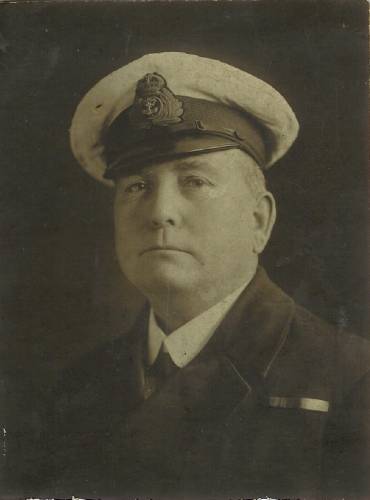

Alfred Vingoe 1869 -1954
A Full and Varied Life
Alfred VINGOE was born 19th of December 1869 at Newlyn, West Cornwall, a son of Thomas Ellis VINGOE [1816-1879] & his 2nd wife Mary Ann Payne nee Wills 1828-1905.
He was the youngest member of a very large family with two half brothers & two half sisters from his father's first marriage; a half brother and sister from his mother's first marriage as well as his three full sisters and 2 full brothers. This eldest of this family of eleven children was 29 years older than Alfred and consequently the first family were married with children of their own at the time of his birth. Many of their children were closer to Alfred in age. My grandfather, son of Thomas Ellis Vingoe II, was a nephew of Alfred but only 4 years his junior.
Alfred's mother, Mary Ann was the widow of a Samuel PAYNE and had been a WILLS before her first marriage.
Alfred's father, Thomas Ellis VINGOE had first married Margaret Pollard GILBERT but she died after giving birth to their fifth child Margaret Gilbert VINGOE on 12 Sept 1851. Mother and child died within days of each other, leaving Thomas Ellis a widower with a young family to look after. For full information on the family go to the tree.
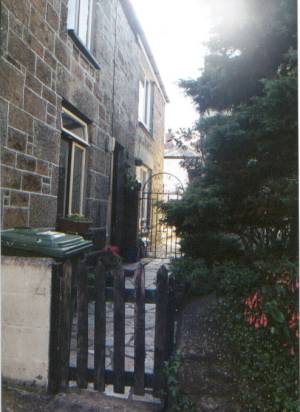 The
family lived at Prospect Place, Trewarveneth St, Newlyn Town & although the
house was
small, a total of 5 adults and 6 children occupied the premises on the night of the
1871 census. These were as follows:- Thomas E VINGOE: his wife Mary Ann plus
their 6 children
: Margaret + Sarah Ann + John + Francis James + Martha Louise &
Alfred. Also present; Sam Payne: 21, fisherman + Mary Payne : 19,
dressmaker: James Wills:
75, shipwright, father-in-law.
Thomas's
children by his first wife had by now left home: three
having married and the fourth, Elizabeth Gilbert VINGOE living with her
married sister, Grace HARVEY in Dist. 4 Schedule. 168
The
family lived at Prospect Place, Trewarveneth St, Newlyn Town & although the
house was
small, a total of 5 adults and 6 children occupied the premises on the night of the
1871 census. These were as follows:- Thomas E VINGOE: his wife Mary Ann plus
their 6 children
: Margaret + Sarah Ann + John + Francis James + Martha Louise &
Alfred. Also present; Sam Payne: 21, fisherman + Mary Payne : 19,
dressmaker: James Wills:
75, shipwright, father-in-law.
Thomas's
children by his first wife had by now left home: three
having married and the fourth, Elizabeth Gilbert VINGOE living with her
married sister, Grace HARVEY in Dist. 4 Schedule. 168
As young Alfred grew up he would have been taken to the Wesleyan Day School by his sister Martha Louise [known as Cissie] who was three years older than him. The headmaster was a Mr Champion and a slipway leading down from the school was named after him. The school was going through a hard time in the 1870's and Ben Batten a Newlyn historian wrote an excellent piece on the school which you can read by going here.
Disease was an ever present threat to life in the Newlyn of the 1800's. On the 23rd of January 1877 Alfred lost an elder sister Sarah Ann age 18, to polio. This was possibly the first of many sad and tragic moments in Alfred's life: worse was to come some two years later.
On the 23rd of September 1879 Alfred's father was drowned whilst fishing off the coast of Whitby. Although the obituary can be read HERE it can never describe the depth of the loss that would have been felt by his wife and young family. Mary Ann was now a widow for the second time with a young family to bring up. Alfred's older brothers, John and Francis James, were with the fleet in Whitby, Francis James being on the boat with his father. The death was hardly mentioned in the Cornish press. The "Cornishman" newspaper carried a small piece whilst the "West Briton" did not carry any report. This was probably because two Cornish boats had been run down by steamers off Whitby in the same week, with the loss of both crews. These boats were the "Malakoff" of St Ives and the "Providence" of Newlyn. Both boats were carrying Newlyn crews of three men each.
Thomas's remains were not found until a week or so later and there was a coroners inquest. In those days there was little hope of bringing the body back to Newlyn for burial so Thomas Ellis VINGOE was laid to rest in the cemetery at Whitby, the grave marked by a headstone. This was later damaged in a storm and has been recently replaced.
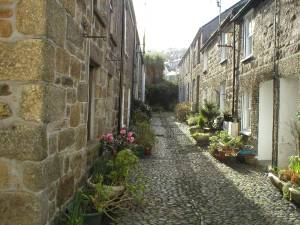 Two
years after his fathers death the 1881 census shows Alfred living with his
mother brothers John and Francis and his sister Martha Louise at number 11
Chapel Street, Newlyn.
It is still there with it cobbled surface almost just as it was then.
The
family home at Prospect Place was now occupied by his half brother,
Thomas Ellis VINGOE and his family. Alfred was by now eleven years old and
may have transferred to the new
Board School on Paul Hill, opened in 1880 and free of charge, a big
help to a widowed mother bringing up a young family.
Two
years after his fathers death the 1881 census shows Alfred living with his
mother brothers John and Francis and his sister Martha Louise at number 11
Chapel Street, Newlyn.
It is still there with it cobbled surface almost just as it was then.
The
family home at Prospect Place was now occupied by his half brother,
Thomas Ellis VINGOE and his family. Alfred was by now eleven years old and
may have transferred to the new
Board School on Paul Hill, opened in 1880 and free of charge, a big
help to a widowed mother bringing up a young family.
We next hear of him in 1885 when he was a trainee on the " Mount Edgecumbe" off Saltash. This was the former wooden walled warship "Winchester" built in 1822. In 1876 she had been renamed and converted into a naval training school. Alfred was on board her as Royal Navy cadet.
His
father's death by 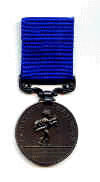 drowning
must have initiated his desire to learn to swim, unlike many seamen of
the time who considered it pointless to try and survive any sinking far out
to sea. They considered it far better to die quickly than to fight against
the elements with little hope of rescue. Alfred's strength and ability in
life- saving was to lead to two dramatic rescues.
drowning
must have initiated his desire to learn to swim, unlike many seamen of
the time who considered it pointless to try and survive any sinking far out
to sea. They considered it far better to die quickly than to fight against
the elements with little hope of rescue. Alfred's strength and ability in
life- saving was to lead to two dramatic rescues.
Whilst serving on the "Mount Edgecumbe" in 1885 he rescued someone from drowning in the Tamar River and was awarded a medal by the Royal Humane Society. 2263 . This heroic act was followed in 1887 by another when he was serving as a Boy Sailor, 1st Class aboard "HMS Skylark" .The Skylark was a sailing ship and whilst at sea a member of the crew fell overboard. Alfred saw him fall and dived straight into the sea from the lower yard arm, where he was working. He manage to hold the man afloat until a boat was lowered to rescue them both. Once again his rescue was recognised by the Royal Humane Society and he was awarded a bar to attach to the medal ribbon of his first award. 23660*
In 1892 Alfred came home on leave to marry Annie Rowe of Madron Parish. The wedding took place on the 20th of August at the Wesley Rock Methodist Chapel, Heamoor. This, as the name suggests, was built over a rock on which the Charles Wesley had preached in the 1700's. Alfred and Annie set up home in Penzance and a daughter Ann Marion was born on Boxing Day 1894. Alfred was at sea at the time and missed the birth.
In January 1895 Alfred was serving on board "HMS St George" in West Africa when the Royal Niger Company under George Taubman Goldie unilaterally changed the rules of the then flourishing palm oil trade. This had sprung up in the early 19th century to replace the illegitimate trans-Atlantic slave trade. Goldie wanted the best of both worlds. He stopped the Ijaw middlemen from shipping oil directly to firms in Britain, whilst at the same time insisting on an unhindered access for himself into the hinterlands where the oil was produced.
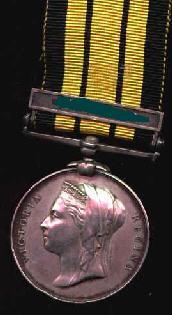 This
did not go well with king Frederick William Koko of the Nembe kingdom and on
January 29, 1895, he assembled a naval fleet of well over 20 war canoes bearing
cannons and headed for Akasa where the Royal Niger company had its operational
base. The place was raided and about 67 white men taken hostage. The king asked
as a condition for releasing the hostages, a return to their former trade
agreement instead of this new oppressive policy. Instead of
negotiating the colonial authorities replied with a full-scale war using
the full force of British military might, of which Alfred was a part. On
February 26, 1895 the kingdom was ruthlessly sacked and more than 2000 people
including many women and children were killed. This operation became known
as the "Brass River Campaign" and like the others who took part
in it Alfred was awarded the East & West Africa Medal with the Brass River
Clasp.
This
did not go well with king Frederick William Koko of the Nembe kingdom and on
January 29, 1895, he assembled a naval fleet of well over 20 war canoes bearing
cannons and headed for Akasa where the Royal Niger company had its operational
base. The place was raided and about 67 white men taken hostage. The king asked
as a condition for releasing the hostages, a return to their former trade
agreement instead of this new oppressive policy. Instead of
negotiating the colonial authorities replied with a full-scale war using
the full force of British military might, of which Alfred was a part. On
February 26, 1895 the kingdom was ruthlessly sacked and more than 2000 people
including many women and children were killed. This operation became known
as the "Brass River Campaign" and like the others who took part
in it Alfred was awarded the East & West Africa Medal with the Brass River
Clasp.
In September 1896 another tragedy struck Alfred when his wife Annie died in an outbreak of typhoid in Penzance. Alfred whose baby daughter was just 22 months old left the navy and returned home to Penzance where he joined Trinity House as a Mounts Bay pilot.
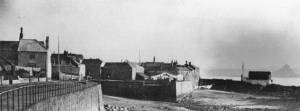
The
pilot boats were kept outside the harbour at Battery Quay. This is the site of
the open air swimming pool today. The pilots would go out from there to meet
vessels arriving at the ports of Penzance or Newlyn and bring them safely into port. They would also take vessels
leaving port a safe distance out to sea before transferring to the little pilot
boat to return to the Battery Quay. The photo above is one of the quay showing
houses on the Barbican, now demolished, with the Mount in the background and the
one on the right is of pilot boats off Battery Quay. These photos date from the
time Alfred was a pilot at the port.
Penzance or Newlyn and bring them safely into port. They would also take vessels
leaving port a safe distance out to sea before transferring to the little pilot
boat to return to the Battery Quay. The photo above is one of the quay showing
houses on the Barbican, now demolished, with the Mount in the background and the
one on the right is of pilot boats off Battery Quay. These photos date from the
time Alfred was a pilot at the port.
In October 1897 Alfred married his second wife at the Penzance Registry Office. The bride was Mary Ellen James whose parents were George and Mary James of Newlyn Road, Paul. The couple were to have a total of eight children between 1898 and 1919. (full details)
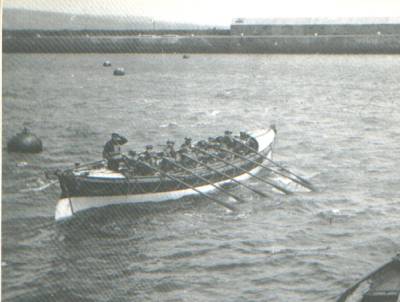
Penzance Lifeboat with Alfred at the helm
Alfred had also become a member of the crew of the Penzance lifeboat "Elizabeth and Blanch" and was coxswain between 1907-1909 when it was based in Penzance. Some records show that Thomas Ellis VINGOE, my grandfather, was also a member of the Penzance crew. When it was moved to Newlyn sometime in 1909 he took over from his uncle as coxswain. Thomas's brother, Robert, [1875] was his Bowman & a cousin, Arthur VINGOE [b1886] his assistant cox. Thomas's brother-in-law Robert SAMPSON was also a crew member. I remember my Dad saying mostly "cousins" and "family" made up the crew of that lifeboat "one way and another" by which he meant those that married into the family as well. Between the years 1908 and 1914 Alfred and Thomas saved 72 lives between them including 20 men from the "Clan McPherson of Glasgow. But, according to his obituary, Alfred was remembered for a rescue undertaken from his pilot boat and not from the lifeboat.
On the 18th of June1909 Alfred was returning to Penzance in his pilot boat when he noticed that a large sailing ship was low in the water and flying distress flags. He and his two crew members sailed over to the craft which was the "Leon Burau" to find that the ship had been holed on a rock off the Scilly Isles and was fast taking in water. Climbing aboard Alfred told the captain to put on full sail, and when this was done Alfred piloted the ship into Penzance where he beached her just outside the harbour. The next day was a Sunday and people were amazed to see this fully rigged sailing ship ashore just outside the harbour entrance. Alfred arranged for most of the cargo to be discharged into small ships and then at high tide the ship was towed into the harbour to be repaired. A full account of the rescue is given in the "Cornishman" newspaper.

In November1913 Alfred sailed aboard the "Seguranca" for New York en route to take up an appointment as pilot and harbour master at the Island of Curacao. The emigration records at New York's Ellis Island show him as an alien & that he had been to USA before, namely Portland and San Diego. This was probably whilst serving in the Royal Navy.
In 1914 we find an Alfredo Vingoe arriving in New York from Venezuela. This turns out to be Alfred who gave his ethnicity as Cornish and his place of residence as Newport, Curacao, W. Indies. He also gave his home as being at 10 Morrab Place, Penzance. This house had been built and lived in by a Henry Vingoe [1780-`1858] and afterwards his son William Henry Vingoe [1807-1888 ] and then his granddaughter Emily QUANCE [neeVingoe]
How, why or when Alfred Vingoe came to live in the property previously occupied by Richard and Emily Quance I have been unable to discover. I had always understood Alfred was left a house in Clifton Terrace, Newlyn, by his father's brother, Richard Mann Vingoe but he appears to have never lived in it.
Alfred was a member of the Royal Navy Reserve and he returned to Britain to take up a position in the Royal Navy in the first World War. His obituary published in the "Cornishman" newspaper on the 18th July,1954 tells us that he was appointed King's Harbour Master at Penzance and then served as skipper on one of Britain's top secret "Q" boats. These were Britain's answer to the German's U-boat. The fighting vessels were a great trick of disguise and cunning - they were actually ordinary ships built as decoys. In the ports of the South West, ships of every shape and size - trawlers, steamers, schooners and cargo ships were all transformed secretly into men-of -war. The ships nickname was after the original 'Q' numbers given to some of these special service decoy vessels. Alfred's ship was Q9. Alfred's grandson, Syd Vingoe, says he was told this was a "Brigantine square rigged on the foremast and fore and aft on the mizzen" Whether this was the same vessel as H.M. Trawler "Yokohama" we are not sure. There is an account on record at the Public Records Office (ADM 156/123) of an incident which resulted in Alfred being summoned before a "Court of Enquiry into the possible sinking of one of his Majesty's submarines by HM Trawler YOKOHAMA. Chief Skipper A. Vingoe RNR. Admiralty 23 June 1917."
This "Yokohama" was some 291 tons and had been built in 1909. The Royal Navy hired her from 1915 to 1919 and she was fitted with a twelve inch gun. On April the 8th 1919 Alfred is listed in the Royal London Gazette as being "Mentioned in Dispatches", yet another award for bravery and he was able to wear the bronze oak leaf with his other medals.
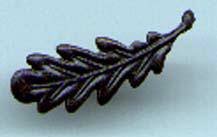
Alfred was now aged fifty and you may think he would have been ready to put his feet up and take life a little easier. This was not the case, however, and in January 1921 he with Mary Ellen and seven of the children boarded the White Star Liner "Adriatic" in Southampton and set sail for the United States of America.
The ships manifest tells us that he was sailing to join an American minesweeper and that the tickets of the whole family had been paid for by the British Government. He gave his occupation as a master mariner and the other members of the family were listed as follows
| Name | Age | Relationship | Occupation |
| Mary Ellen | 47 | Wife | Wife |
| Ruby Winifred | 21 | Daughter | Typist |
| Cecil George | 20 | Son | Seaman |
| Roma Violet | 16 | Daughter | Typist |
| Mary Louise | 15 | Daughter | - |
| Lauretta | 14 | Daughter | - |
| Francis Warwick | 10 | Son | - |
| Bertha Margaret | 9 | Daughter | - |
All the family had there final destination down as the home of W R James at E. William Street, Pittsburgh, Kansas.
William JAMES was the brother of Alfred's second wife and the husband of Ann Marion Vingoe b. 1894, Alfred's daughter by his first wife. William had left Cornwall to work in a coal mine in Wales and he and Marion had then emigrated from Wales with their daughter Marie to Pittsburgh, Kansas in June 1920. Pittsburgh was "a small, rough, coal mining town" and I don't think that Alfred and his family stayed there very long before moving with his family to Coronado, California. His grandson Syd tells me that they" travelled with all the children part of the way by car with a barrel of water tied on the bonnet....must have caused a few remarks during prohibition"
In Coronado they were once again living by the sea and Alfred became a member of the Yacht Club but he also sailed in merchant ships.1927 finds him working as the "Master at Arms" on the liner "Kroonland" bound for San Francisco via Havana and Los Angeles. His son Cecil is also a crew member sailing as a mess boy. Both are listed as being American citizens.
14 years Alfred and and Mary Ellen returned to Newlyn in 1935 where they lived in retirement together in his mother's old house at 11, Chapel Street. He died on the 13th of July 1954 some twenty years after returning from the States and is buried in the Municipal Cemetery, Sheffield Road, in the village of Paul. Below is a photo of his grave with details. Two years later Mary Ellen also died aged 82 years having also lived a full and interesting life alongside her husband. There children grew and some had families and below I give some information on them.
Alfred as a boy sailor 1890's and in later life & Mary Ellen his second wife
Click to see larger photo.
Click to see larger photo.
In loving memory of
Captain Alfred Vingoe
Harbour Master, Lifeboat Coxswain,
Master Mariner & Pilot
1869 - 1954
And His Beloved Wife
Mary Ellen Vingoe
1873 - 1955
0-0-0-0-0-0-0-0-0-0-0-0
George
James:
Father in Law to Alfred Vingoe and also Father-in-law to his daughter Marion Vingoe.
![]()